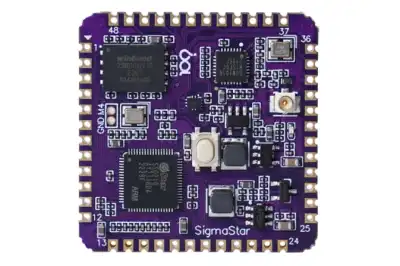The DongshanPI-PicoW is a small Linux-based board with dual-core at 1Ghz, 64MB of RAM, 128MB of flash, and WiFi connectivity for $7.
For several years, I have been saying that the future of microcontrollers is probably Linux. As processor power increases, it is inevitable that solutions like Arduino or even the ESP32 will be relegated.
A good example is that, recently, various boards with Linux have appeared. They have in common that they have few resources (compared to, for example, a Raspberry Pi), they mount lightweight versions of Linux, have a very small size, and a very low price.
The DongshanPI-PicoW is a good example of this trend. It incorporates a dual-core Cortex-A7 processor at 1Ghz SSD210 from SigmaStar, with 64MB of RAM. In terms of storage, it has 128MB NAND SPI.
These are limited resources, but sufficient to run a lightweight version of Linux. And quite impressive, considering its size of 31 x 31 mm.
The DongshanPI-PicoW has wireless connectivity thanks to the incorporation of an SSW101B chip that provides 2.4GHz WiFi 802.11b/g/n.
The board’s perimeter is surrounded by four rows of holes, for a total of 48. Programming and connection must be done through these pins, without any port or connector on the PCB.
The main specifications are as follows,
- SigmaStar SSD210 dual-core Arm Cortex-A7 processor at up to 1.0GHz
- FPU, NEON, MMU, DMA, 2D graphics accelerator
- 64MB DDR2 RAM on the chip.
- 128MB NAND SPI Flash storage (Winbond W25N010).
- WiFi 4 Sigmastart SSW101B 2.4GHz 802.11b/g/n
- 1x Ethernet 10/100M
- Four 12-pin headers with 2.0mm pitch.
- 1x SDIO 2.0, 2x SPI, 2x I2C, 4x UART, 4x PWM, GPIOs.
- TTL display output up to 1280x800 60fps.
- Audio - MIC and DMIC inputs, line output, 8-channel I2S/TDM with 2/4/8 channel Rx,
- 2-port USB switch Onsemi FSUSB30.
- 5V power supply through input/output pins.
- Dimensions - 31 x 31 mm (estimated).
- DongShanPi-PicoW USB programming for debugging.
However, don’t be fooled. It’s a tough board to use. Don’t expect anything like a Raspberry Pi. Making this board work is going to be a small hell.
In particular, the DongShanPi-PicoW does not have any installed port or connector. Programming and connection must be done through the available pins. Frankly, I think a reusable carrier board to facilitate programming would be a great addition to the whole setup.
As is often the case with these types of boards, the documentation is scarce. In this case, part of it is exclusively in Chinese, so you will have to rely on Google Translator.
A specific tool from the manufacturer is used for programming and flashing. A Linux image is also provided. More information on the product page at https://dongshanpi.com/DongshanPi-PicoW/01-BoardIntroduction/
The DongShanPi-PicoW is very interesting for advanced projects, where you really need a mini (very mini!) computer with Linux, such as robotics and IoT applications.
The board is sold on Aliexpress for €7 plus shipping (around €10 in total). But keep in mind that to program it, you will need at least an external TTL converter.
